Hammock camping is growing in popularity and is becoming a preferred way for people to camp with less of a footprint. There are so many advantages to camping in a hammock when compared to traditional tent camping. I know for my family when we switched from a tent, it was a significant change, but a change for the better.
There was definitely a learning curve when switching to hammocks and I wasn’t as well prepared as I should have been. I made many of the mistakes listed on this page when I was first starting out, so my hope is that you will learn from my errors and have a better experience.
So let’s get into the top 25 mistakes many people make when starting out with hammock camping. This list is just a birds-eye view of potential oversights. I have written more detailed articles on most of these topics so you can also read those if you’d like more information on a specific topic. Without further ado, let’s get into it.
1. Not doing your homework
Research. Research. Research. I cannot stress this enough and it is for this reason that this is at the top of this list. Hammock camping has a lot of nuances and there’s a lot to learn. It’s not one of those things that you can just fly by the seat of your pants and hope it all works out. Sure, you can buy a hammock and figure it out as you go, but there will be a steep learning curve and some uncomfortable nights if you do. Be prepared and do some research. There is a ton of information out there to help you and will take a lot of the guesswork out. After all, you want to enjoy your time being in nature and relaxing, don’t you?
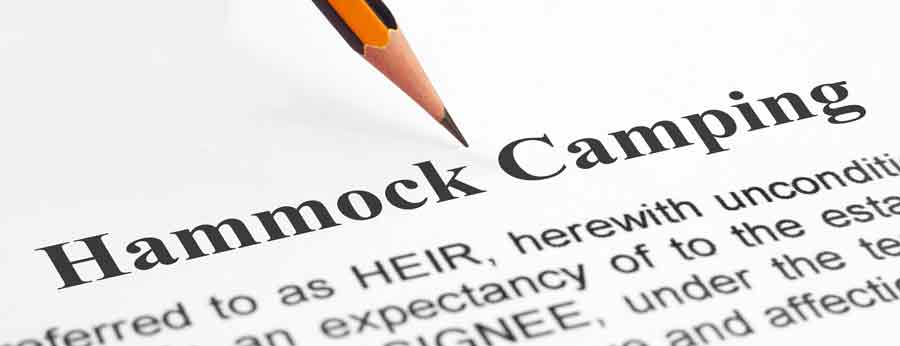
2. Not practicing
Practice makes perfect. It’s important to practice setting up your hammock correctly before you head out on your camping trip. I’m not sure why people tend to skip this step and don’t at least practice in the backyard first. Setting your gear up ahead of time is critical to having a successful trip. While having the knowledge of how to set up is one piece of the puzzle, the other is to be sure that you have all the gear required for a successful setup. You definitely don’t want to be in the middle of the woods setting your campsite up and not have the gear you need.
This is especially true if you have brand-new gear. You should always make it a habit to check the integrity of your gear and equipment before your trip. There would be nothing worse than getting your gear out and ready to set up only to find out that the hammock you bought that was supposed to come with straps, doesn’t have the straps with it. Where will you sleep? The ground, my friend.
Setting up your hammock properly is kind of an art. Honestly, you have to find that “perfect hang” to ensure you are going to have a comfortable night’s rest. I personally set up and practice every single time I get a new piece of gear. First and foremost, no matter what the gear may be, I practice using it to ensure that it works as it should. Second, I make sure that I actually know how to use it correctly. It’s better to figure stuff out when you’re at home with the internet to bail you out if you run into trouble. I can’t tell you how many times I have consulted other blogs and YouTube to help me out with troubleshooting my gear. That being said, practice, practice, practice.
3. No insulation system
Not having the proper insulation is a very common mistake that new hammock campers make. It’s a lesson that is quickly learned and one that you can prevent. When moving from a tent to a hammock, the convection transfer of heat is often underestimated. You have 360 degrees of airflow around you. If you aren’t familiar with convection, let me explain. When your body is directly up against the thin nylon, the air flowing around you literally steals your body heat and draws it away from you and into the environment. Nature’s way of reaching equilibrium can cause quite the problem for hammock campers. It is for this reason that you should always have some type of insulation system to keep you warm.
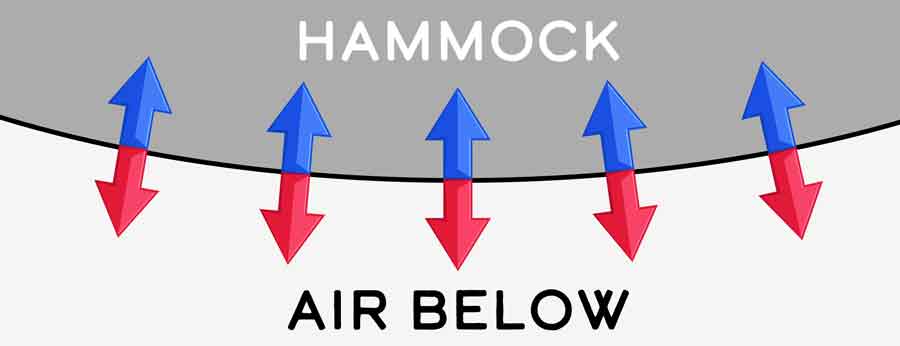
There are many ways to insulate and the type of system you choose will depend on your situation and the temperature you plan to camp in. An underquilt and insulated sleeping pads are two of the most popular insulation systems. However, there are other budget-friendly ways to insulate as well. Everyone eventually finds their go-to insulation system or systems. Many people have multiple ways to insulate depending on the situation.
The thing to keep in mind is that you can still get cold in seemingly warm temperatures. The typical rule is if the overnight lows get lower than 70 degrees, you should have some kind of insulation. I’m not kidding. You will freeze your butt off if you’re not protected. I have gotten chilly on nights that are 80 degrees. It is important to be prepared and know ahead of time the high and low temperatures and the expected winds of the days and nights you will be camping. The more wind, means the more you will need to insulate to keep convection at a minimum in order to keep warm and comfortable. Don’t underestimate how vital insulation is. If you are just starting out, and don’t know what insulation to use, or if you need it, start testing some out. Be on the safe side and bring it with you. It’s better to have the insulation and not need it as opposed to the other way around. Trust me.
Article: Do I need an underquilt or sleeping bag
4. Not bringing a tarp
One of the best things about hammock camping, in my opinion, is the stargazing. Swaying in the gentle breeze, staring at the stars is hands-down the best way to drift off to sleep. However, the weather can be rather unpredictable and sometimes your stargazing is going to get rained out.
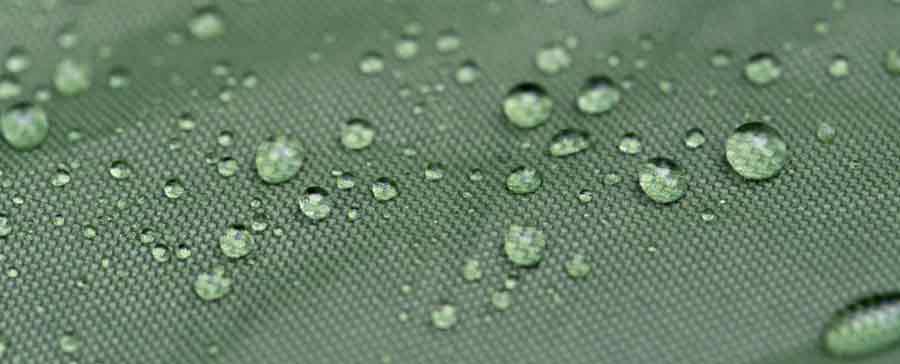
My general rule is to always have a tarp with me in the case that the weather forecast is incorrect and it rains when it isn’t supposed to. It actually happens a lot while I’m out, an unexpected pop-up shower happens more often than not. This isn’t the case every time you’re out camping, but the weather doesn’t stop just because you’re in your hammock. I’ve seen it happen to others and I always feel terrible for them. I’m one to err on the safe side and always be prepared. Much like having proper insulation, I would rather have my tarp available even if I don’t need it, than not have one at all and have a very soggy, uncomfortable night.
The biggest takeaway, don’t always trust weather predictions and always have a tarp just in case. You’ll thank me later.
5. Underestimating Mother Nature
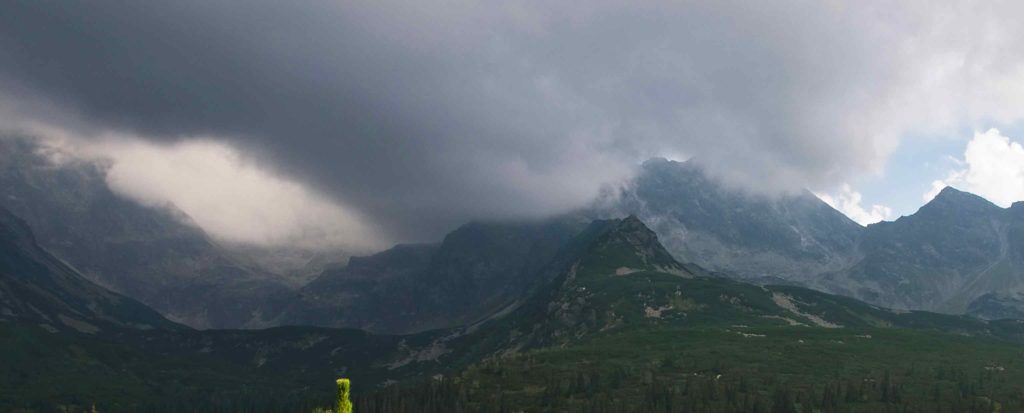
To drive the point home one more time, this ties into the last two tips – don’t trust the weather. Ever. Most of the issues I’ve seen others have, and have personally had, are because of unpredictable weather. You really can never be sure what you’re going to get. My biggest piece of advice is just be prepared for the weather and make room in your pack for the extra gear no matter what. A couple of extra pounds is well worth the sacrifice, if you ask me.
6. Not using straps
YOU MUST USE STRAPS! Not to get all dramatic about it, but this is important. Please, don’t use rope or paracord to hang your hammock. Get the proper straps. I can’t stress this enough. The all goes back to my first tip on this list – do your homework. Research and study the proper way to hang a hammock. If you use anything other than straps, you will be damaging the trees you use to hang from.
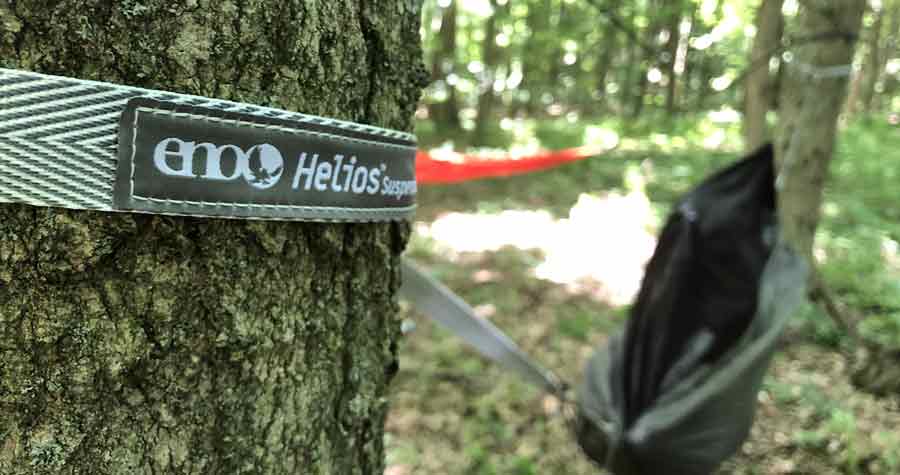
When you use rope or paracord to hang a hammock, you are doing it wrong. Hammock straps are designed to distribute the weight without causing harm to the trees. Also, if you need a better selling point, straps are a whole lot easier to use and set-up is much faster. Always make sure your straps are at least ¾ of an inch in width. If you use anything other than straps, you exponentially increase the risk of hurting the natural environment and leave more of a footprint than if you were tent camping. In fact, some parks don’t allow hammock camping due to the damage caused to the trees by negligent campers. Don’t be that guy or gal…
7. Hanging too tight
You need to have some sag. Don’t hang your hammock too tight. This is a super common mistake and can lead to an uncomfortable rest. To have a good hang, you want to try to get about a 30-degree angle on your straps. The sag allows you to position yourself at an angle and get a more flat lay. The sag is key to getting a good night sleep.
8. Preventing the ‘slide’
Sliding down in your hammock while you sleep can become quite annoying and I see and hear of people struggling with this. Having your head or feet too high above the other can be problematic and lead to sliding in either direction. Most people that complain about sliding down are attempting to keep their head too high in the hammock. The secret is to find your center mass. It works well to have your feet just slightly higher than your head in order to prevent sliding. Since you have gravity working against you, being closer to the middle of your hammock will decrease the potential of sliding down.
9. Improper tree selection
I can go on and on about this one. To start, I wrote a rather lengthy article on everything you will ever need to know about picking the right trees. This topic is crucial so if you are unsure about how to choose the right trees, you can learn more at the link below:
YOU MAY ALSO ENJOY: 12 Tips for Choosing Trees for Hanging Your Hammock
So for those of you that just want the abridged version:
When selecting the right trees, you want to look for several things. First, you want to look at the spacing between the trees. Then you want to examine each tree thoroughly to ensure that it is in good health. Inspect the trees by looking closely at the bark and be sure that there is no exposed wood or peeling bark. If you see any damage to the tree, move on and find another.

You also want to be sure that the trees you choose are mature and the diameter of the tree trunks are large enough to safely accommodate your hang. The goal is to keep the trees as healthy as possible and not do any damage. The trees shouldn’t even know you were there.
The last major thing you have to look for is what’s above you. This is critical for your safety. Make sure the tree is healthy and you see all the leaves. Be absolutely sure that there are no dead branches in the trees. These are what are called, Widowmakers. These dead branches hanging out in high in the tree can come crashing down at any time. If you are in the way, they can potentially kill you hence the name. Don’t mess around with this and take your time looking for them.
10. Not sleeping at an angle
Sleep at an angle if you actually want to be comfortable. Don’t sleep parallel to the trees. I know you see the stereotypical pictures of people chillin’ in their hammocks parallel to the trees in magazines and online. It’s picture perfect relaxation, right? Well, not if you actually want to sleep comfortably. If you sleep at an angle, you will be able to lay flatter and have a better night’s rest. Bottom line, sleeping like a banana or a pea-pod is not going to provide any comfort.
11. Not looking at what’s growing around your campsite
This is one mistake that will cost you and I don’t mean your wallet. Again, this ties back to point number one, to do your research. Know the poisonous plants in your area before you head out. If you don’t know what you’re looking at when you inspect your trees, you could unknowingly wrap your straps around a tree that has a poisonous climbing vine on it.
I’ve heard some terrible stories about hammock campers getting covered in poison ivy or poison oak on a camping trip. They didn’t know what the plants looked like and weren’t aware of how they grew. They contaminated themselves and all of their gear with poisonous oils and had a miserable time. Know your poisonous plants. Know what they look like, know how and where they grow, and know how to identify them quickly.
12. Not using a mosquito net
Bug nets are on the list of essential gear for hammock camping. Much like poisonous plants, insects and other creepy crawlers in the woods can make your time out there equally as miserable if you’re not prepared.
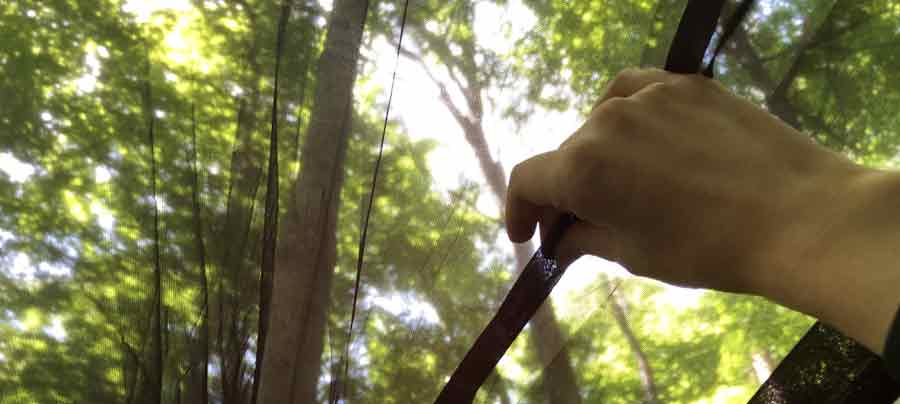
Hammocks require different equipment for various situations. Bug nets are a non-negotiable piece of equipment to have on hand, in my opinion. They are often forgotten about and hard lessons are learned. If you don’t have a bug net, you have basically made yourself a buffet with a neon sign saying, “All you can eat!” It’s a terrible thing to wake up with bug bites all over you, not to mention the itchy days that follow. That’s why you should always carry a bug net.
There are two major types of bug nets: Integrated bug nets that are attached and sewn to the hammock and separate bug nets that wrap around the entire hammock. No matter which you choose, the important thing is to have one.
YOU MAY ALSO ENJOY: Do I need a bug net for hammock camping?
13. Fearing your knots
Knowing knots is just something that comes with the territory of hammock camping. There are systems out there that are no-knot setups, but knot tying is something I strongly suggest you learn. Not just learn, master them. There are dozens of options for knots when using a hammock, but you can get by with knowing just three or four really well.
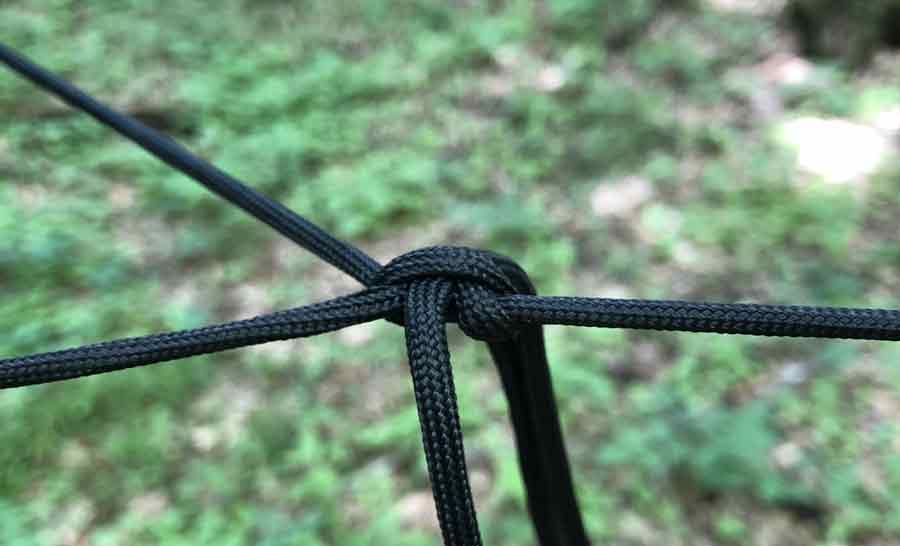
People doubt their knot tying abilities a lot. It just takes practice. I used to keep a bit of paracord in my pocket all the time and when I was bored or waiting somewhere, I would practice my knots. If I’m honest, I still keep some on hand just for my boys. Beats the hell out of pulling out a phone or other screen for entertainment. There are tons of great resources out there that will teach you how to tie the various types of knots. Before you know it, you’ll be a master at knot tying.
14. Incorrect hammock height
There’s a saying when it comes to hammock camping, “Never hang higher than you’re willing to fall.” Words to live by, indeed. Safety should always be your number one concern and at the forefront of your mind while you are hammock camping.
A common problem I still see new hammock campers make, is they get their hammock height wrong. This is an overlooked but important aspect to hammock camping.
The typical height for a good hang is around 18” off the ground. This way, your feet barely touch the ground when you are sitting in your hammock. The opposite can also be a problem. Hanging too low can damage your hammock if there are rocks underneath and your hammock spends time rubbing against them. Keep yourself and your gear safe by setting up your hammock at the proper height.
15. If something isn’t right, fix it!
As you might already know, or will soon find out, hammock camping isn’t like tent camping. There is a science to it. You will find yourself continually experimenting to find ways to get your perfect hang. The key is to always fix any problem that arises. Small tweaks here and there are to be expected. This comes back to the whole ‘you need to practice setting up your hammock’ concept. Don’t settle for discomfort.
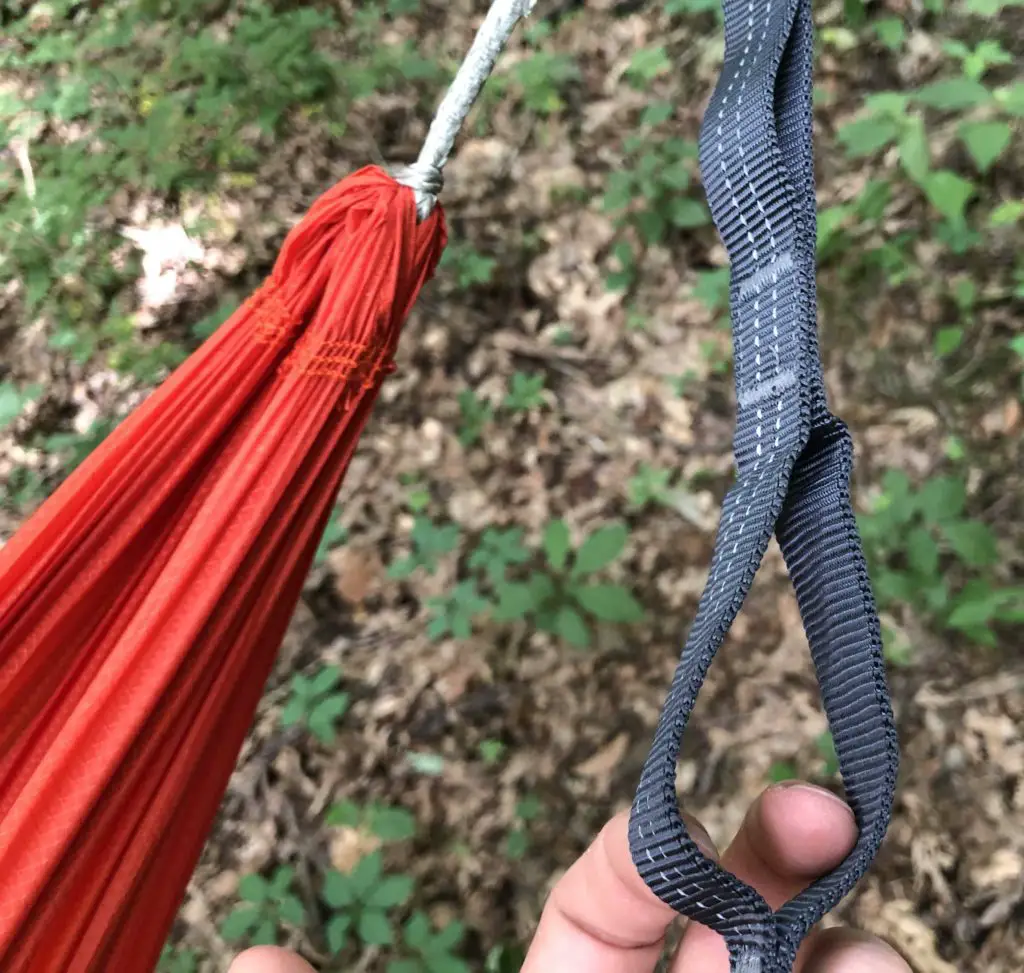
Experiment and fiddle with your adjustments until you get it right. This is especially important in inclement weather. Even the smallest adjustments to your hammock and tarp may seem insignificant, but they can truly make the difference in whether you stay dry all night long or get soaking wet.
16. Preventable falls
Be sure to open your hammock completely and get into it slowly. Pay attention to what you are doing. This probably seems like common sense and maybe even slightly humorous, but it’s not all that funny when you fall from your hammock. You would be surprised at the stories I have heard of people attempting to get in or just sit in their hammock, but missing the hammock completely leaving them on the ground. It is also possible to mistake your underquilt for your hammock ending in the same result. Luckily, this has never happened to me and I hope it never does. I hope it doesn’t happen to you either.
17. Not staking the tarp down securely
This isn’t rocket science, but not securely staking the tarp down is a really common mistake. I have personal experience making this mistake. On a windy day, a tarp or rain fly becomes more like a big sail just waiting to catch the wind. I learned the hard way. Believe me when I say it’s crucial to make sure that you properly drive in your stakes. Drive them in deep and secure. Make sure you have the proper tension on your rain fly.
Depending on the size of your tarp or rain fly, try to get it to touch the ground in order to prevent the wind from getting up under it. The last thing you really want is to wake up or come back to camp and see your rain fly flapping in the wind – or worse…it’s completely missing. You will also have to worry about your hammock being wet if it loses the protection of the rain fly. All these things can happen and have happened to myself and others so please learn from the mistakes of those who have gone before you.
18. No drip lines
Have drip lines. Do your research and learn about water breaks. A hammock is essentially a water bridge from one tree to the other. Water will always follow the path of least resistance – because, physics. For example, if your strap is angled at 30 degrees off of the tree, the water will flow right down that strap into your hammock. You will probably get wet if you don’t prevent it. It’s important to make drip lines.
Typically people just use a bit of paracord and use the lark’s head knot and tie it to the middle of the straps. This allows the water to absorb into the paracord and then follow gravity by traveling down the string and dripping off onto the ground and not your hammock – hence the name, drip line.
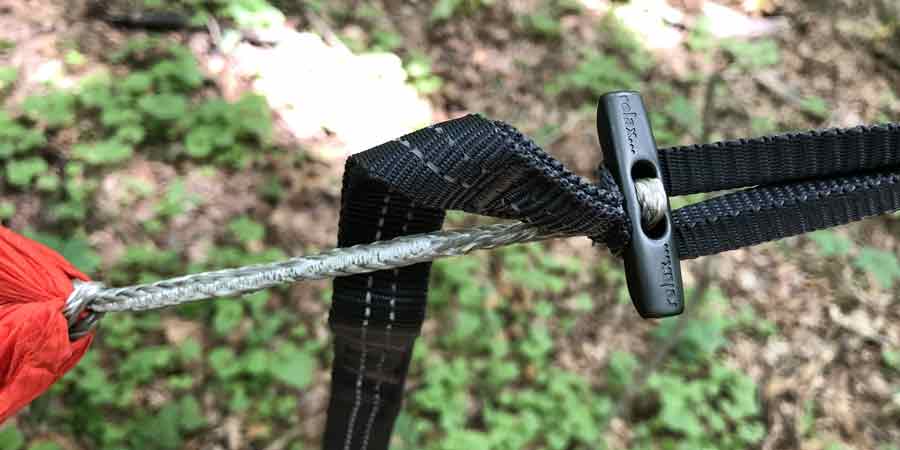
I always have paracord drip lines attached to my straps because you never know when your might get caught in the rain.
19. Hammock too close to fire
Don’t hang your hammock too close to your campfire. Again this probably seems like common sense, but I have to mention it. If you haven’t already noticed, safety is always on my mind. I believe that safety should always be everyone’s number one concern when exploring the outdoors. The number one safety concern is, or always should be, fire safety. Hammock camping is no exception. It is super important to remember that most of your hammock system is flammable.
Most hammocks and tarps are made of nylon, which is a synthetic material made of plastic – and plastic melts. One small ember from the campfire can fly over and burn a hole right through your hammock or tarp. It is for this reason that you always want to ensure that you keep your hammock at a safe distance from your campfire.
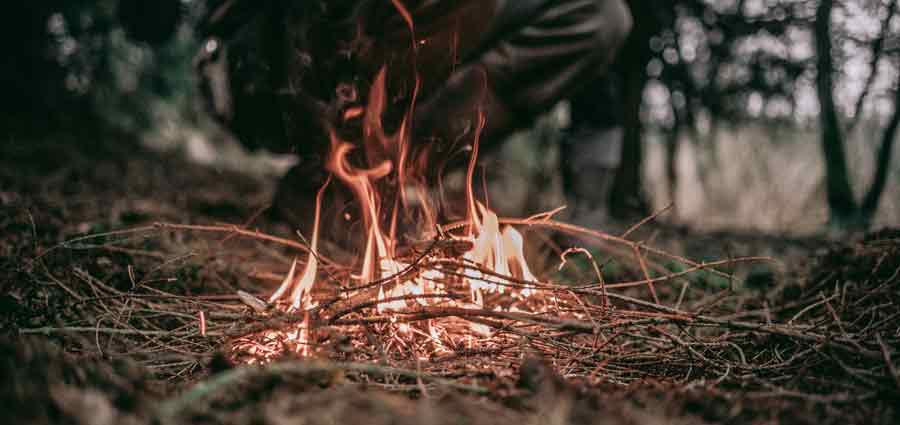
I always recommend hanging your hammock no closer than 9 feet from the fire. The likelihood of an ember hot enough to burn a hole in your gear decreases at this distance – the embers that do reach you will have cooled significantly. Because I’m such a safety nut, I wrote a full article explaining how to hammock camp safely around fires.
YOU MAY ALSO ENJOY: Can I hammock camp with a fire under my tarp?
20. Not using established campsites
Most hammock campers I know are very conservation minded. They make the choice to switch to a hammock in an effort to decrease their footprint on the woods when they camp. The goal is to leave the woods how you found them and without disturbing the wildlife.
Taking advantage of and using already established campsites, rather than building a site of your own, will help to keep the woods the natural paradise that we love. It is important to be mindful of the impact you are making on the woods and wildlife while you are hammock camping.
I’m not saying that you can never build your own campsite because you will find many times it will be your your only option. All I’m trying to get across is that we should always use established sites if they are available to us. Remember, leave no trace.
21. Camping where hammocks are prohibited
Now that hammocks are becoming more and more popular, it is also important to be sure and check ahead of time that your destination allows hammock camping. As with anything in life, there are pros and cons to camping in a hammock.
Most of the cons come from the inexperienced hammock campers who use improper equipment for their hammock set ups and cause irreparable damage to the trees they used to hang from. Instead of proper straps, they use paracord or rope that cuts into the bark of the healthy trees and puts them at great risk of disease or even death.
It’s such a serious problem that some National, State, and Metro parks completely prohibit the use of hammocks. So in this case, the few have ruined it for the many. Just be aware that your planned destination may not allow hammock camping and plan accordingly.
22. Forgetting gear
This is a big one and I will bet anything that most of us, even the most experienced of us, have forgotten gear. This isn’t only true for hammock camping, but any kind of camping or hiking trip. We are human we forget stuff. However, as a hammock camper, you have to be extra mindful and check, double check, and triple check your gear before you leave. We often don’t have the luxury of ‘making do’ without the forgotten gear. All of our gear is important for proper setup and to stay comfortable.

Forgot your straps? Looks like you’re not hanging in a hammock tonight. Forgot your rain fly? You’ll likely be sleeping under the stars in the rain. Every piece of equipment is crucial when it comes to hammock camping so. Go over it a few times and ensure you have everything. Being a hammock camper means you have to always be more prepared than the ground dwellers.
23. Not pacing between trees
It sounds a little silly, but pacing helps you determine the distance between your trees. Sure, when you get more experienced at ‘eyeballing’ distance, you may not have to do this, but it is always a good idea for beginners.
Pace out the distance between your trees so you can get a good hang that isn’t going to be too tight. You will need 30 degrees for a good hang, meaning you will need to count out 6 paces between trees. This all goes back to selecting the right trees and the distance between them is important to get right. That is, if you want to be comfortable. If you’re not into comfortable sleep, then you can skip this step.
24. Only trying what you’ve read
There are a lot of amazing and helpful resources that will help you learn how to hammock camp like a pro. There are so many awesome blogs, youtube channels, forums and other resources to learn from.
I believe that one of the best things about hammock camping is how versatile it is. I can get creative and look outside the box to find my own solutions. There are so many different gear options out there to experiment with.
What color hammock do you want? What type – single or double? Bug net – integrated or separate? Sil-Nylon Tarp or Ripstop Nylon Tarp? Underquilt or Sleeping Pad? I couldn’t even name all the options if I tried. You can mix and match as much as you’d like too.
The takeaway – feel free to experiment and don’t just go with something because you read about it somewhere. I encourage every one of you to do your homework and take advice with a grain of salt. Develop your own system and don’t be afraid to tweak it to your liking. As long as you achieve your ideal hang, do what works for you.
25. Afraid of DIY hammock solutions

This kind of goes along with the last tip mentioned. There are many Do It Yourself options out there when it comes to hammock camping. I would strongly encourage you to explore and try out DIYs. They can sometimes be better and also often more cost-effective. Don’t be afraid of sewing. Learn it or get a friend who knows how to help you out. There are a lot of great hammock plans and projects if you just look for them and aren’t afraid to try something new.
You Now Know How to Prepare
A lot of the items on this list come from my personal experiences as a new hammock camper or someone that has shared their cautionary tales with me. I truly hope that you learned a lot and that it might have even inspired you to do more research on a given topic or two, or many.
Don’t be ashamed if you have made some of these mistakes. We all have at one point or another. When you know better, do better.
No matter where your travels take you, I hope you enjoy The Wanderful Wild
